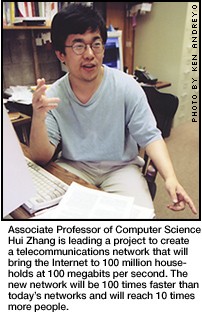|
|
||
|
|
|
Carnegie Mellon Leads the Charge in Project To Rewire America � The National Science Foundation (NSF) has made a $7.5 million grant to a collaboration of scientists to lay the groundwork for a new, wireless, glass fiber-based telecommunications network that will bring reliable high-speed Internet access to every home and small business in America within the next few years. �
"What the copper-wired telephone network was to the 20th century, the fiber network will be to the 21st," said Zhang. "Today we have 500 kilobits reaching 10 million American homes. We want to make the system 100 times faster and reach 10 times more households. But we must make the system more manageable, more secure, more economical and more scalable, and we must create an infrastructure that can support applications not yet envisioned." ��� The creation of a network to serve 100 million households with two-way symmetric data communications service at 100 megabits per second is a tremendous challenge that reaches far beyond technological issues. Universal availability of such a network would bring fundamental changes to daily life and potentially raise the standard of living substantially. The barriers to its creation are not simply deployment or cost issues. It will require fundamental innovations in the way networks are organized and managed. In addition, the research group must develop communication architectures well suited to large-scale deployment that can operate inexpensively at very high speeds. � To achieve their goal, the collaborators will start from basic principles and undertake fundamental research that addresses the design of an economical, robust, secure and scalable 100x100 network. Then, they will construct proof-of-concept demonstrations to show how it can be built. � Zhang said the physical testbeds created through the project can be used as a basis for further studies, such as social science research on the impact of connectivity in the home. The software and tools used to design and validate the network, particularly the emulation systems, will be used to create new curricula for network education in two- and four-year colleges. In fact, plans are already under way for an outreach program. ��� "We will attack pieces of the problem according to our expertise and get together to hash out the architecture and develop some initial answers," Zhang said. He expects to have an experimental component at the end of the project in five years. � "The Internet has had a huge impact on society but there are limits to today's network," he said. "We must not be satisfied by the Internet's apparent success. Breakthroughs over the last 30 years have masked its underlying problems. We need to take a fresh look at the architecture considering new requirements and the technology that has changed profoundly in the last three decades. The biggest challenge is to imagine the network beyond the Internet."
Anne Watzman� � � �
�
Top�
�
|
|
This Issue's Headlines || Carnegie Mellon News Home || Carnegie Mellon Home |
||
 The five-year grant for the "100 Megabits to 100 Million Homes" project was made under NSF's Information Technology Research (ITR) Program and is one of eight large grants made from that program this year.
�
The five-year grant for the "100 Megabits to 100 Million Homes" project was made under NSF's Information Technology Research (ITR) Program and is one of eight large grants made from that program this year.
�